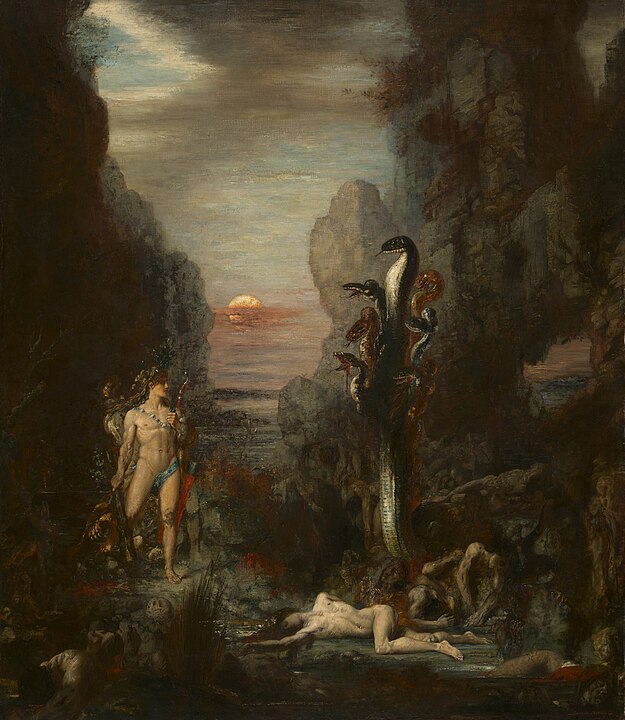
Table of Contents
The Lernaean Hydra is one of the most intriguing yet terrifying monsters of Greek mythology, best known for its connection with Hercules and his 12 labors. Here’s a look at the story and end of the Hydra of Lerna.
What Is the Lernaean Hydra?
The Lernaean Hydra, or the Hydra of Lerna, was a gigantic serpentine sea monster with multiple heads, that existed in both Roman and Greek Mythology. It had poisonous breath and blood and was able to regenerate two heads for every head that was chopped off. This made the Hydra a terrifying figure. It was also the guardian of the entrance to the Underworld.
The Hydra was the offspring of Typhon (said to be the descendent of lions) and Echidna (herself a hybrid creature being half-human and half serpent). As the story goes, the Hydra was raised by Hera, one of Zeus’ many wives, to be a vicious monster with the goal of killing Hercules (a.k.a. Heracles), an illegitimate son of Zeus. It lived in the marshes around the Lake of Lerna, near Argos and terrorized the people and livestock of the area. Its destruction became one of the twelve labors of Hercules.
What Powers Did the Hydra Have?
The Lernaean Hydra had many powers, which was why she was so difficult to kill. Here are a few of her recorded powers:
- Poisonous Breath: It is said that the sea monster’s breath was perhaps the most dangerous tool at her disposal. Anyone who breathed the same air as that of the monster would die instantly.
- Acid: Being a hybrid, with multifaceted origins, Hydra’s internal organs produced acid, which she could spit, bringing a gruesome end to the person before her.
- Several Heads: There are different references to the number of heads that the Hydra had, but in most versions, she was said to have nine heads, of which the central head was immortal, and could only be killed by a special sword. Furthermore, if one of her head was severed from her body, two more would regenerate in its place, making it nearly impossible to kill the monster.
- Poisonous Blood: The Hydra’s blood was considered poisonous and could kill anyone who came into contact with it.
Taken this way, it’s clear that the Hydra was a monster of monsters, with many powers that made killing it a major feat.
Hercules and the Hydra
The Hydra has become a famous figure because of its connection to the adventures of Hercules. Because Hercules had killed his wife Megara and his children in a fit of lunacy, he was set twelve labors by Eurystheus, King of Tiryns, as a punishment. In reality, Hera was behind the twelve labors and hoped that Hercules would be killed while attempting to complete them.
The second of Hercules’ twelve labors was to slay the Hydra. Because Hercules already knew the monster’s powers, he was able to prepare himself when attacking it. He covered the lower part of his face to save himself from the Hydra’s vicious breath.

At the start, he tried to kill the monster by cutting of its heads one by one, but soon realized that this only resulted in the growth of two new heads. Realizing that he could not defeat the Hydra in this way, Hercules devised a plan with his nephew Iolaus. This time, before the Hdyra could regenerate heads, Iolaus cauterized the wounds with a firebrand. The Hydra could not regenerate heads and finally, there was just the single immortal head left.
When Hera saw the Hydra failing, she sent a gigantic crab to assist the Hydra, who distracted Hercules by biting him on his feet, but Hercules was able to overcome the crab. Finally, with the golden sword given by Athena, Hercules severed the last immortal head of the Hydra, extracted and saved some of its poisonous blood for his future battles, and then buried the still-moving Hydra’s head so it could no longer regenerate.
Hydra Constellation
When Hera saw that Hercules had slain the Hydra, she made the Hydra and the giant crab constellations in the sky, to be remembered forever. The Hydra constellation is one of the largest constellations in the sky and is typically represented as a water snake with a long, serpentine form.
Hydra Facts
The parents of the Hydra were Echidna and Typhon
Hera raised the Hydra to kill Hercules, whom she hated as the illegitimate son of her husband, Zeus.
No, the Hydra was a serpent-like monster but was raised by Hera, herself a goddess.
Hercules killed the Hydra as part of the 12 labors set for him by the King Eurystheus, as punishment for killing his wife and children in a fit of madness.
The exact number of the Hydra’s head varies depending on the version. In general, the number ranges from 3 to 9, with 9 being the most common.
Hercules enlisted the help of his nephew to kill the Hydra. They cut off the Hydra’s heads, cauterized each wound and used Athena’s magical golden sword to cut off the final immortal head.
Wrapping Up
The Hydra remains one of the most unique and terrifying of the Greek monsters. It continues to be a captivating image and is often featured in popular culture.








